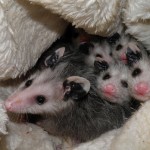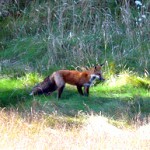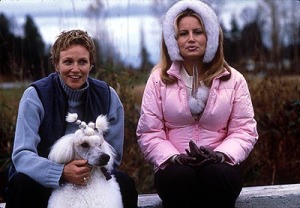 Artist Julian Charrière gave the despised pigeons of Venice’s St. Mark’s Square a flamboyant makeover in green, blue and red. Tourists went nuts for the pretty birds. What did the other birds think?
Keep reading Would you be nicer to pigeons if they were green?
 A “Nature” documentary salutes Toronto’s high density of urban wildlife, but tourism officials want to hide their light under a bushel.
Keep reading Toronto snubs “Raccoon Capital of the World” title
 Heidi the cross-eyed possum was orphaned, probably by a car, then raised at the NC Zoo in Asheboro before heading to 3 European zoos and fame.
Keep reading Asheboro, NC, rescuer unaware they saved Heidi the cross-eyed possum
 Heidi, who was orphaned in NC and hand-raised, became a celebrity in Germany. She was fat and ultimately arthritis did her in.
Keep reading Heidi dies. The fat, American, cross-eyed possum charmed the world from a German zoo
 Fox in news: as pets? cryptid? giant beasts? pushing Navy off island? Euro hunter disputes
Keep reading Foxes pushing boundaries, both as pets, giant pets, hunting targets
 Yellowstone Park rounds up 300 bison; likely to slaughter half to please local cattlemen. Did Heidi the possum go cross-eyed from being fat? Jane Lynch v. AKC
Keep reading 150 Yellowstone buffalo risk slaughter; Possum on diet to cure cross-eyes
 Laboratory beagles like my Moxie and Huckleberry were specifically bred to be experimented on because they are small and docile. Other dogs are picked up by Class B dealers in shelters and “free to good home” ads.
Keep reading Where do laboratory beagles come from?
 German loves Heidi, a cross-eyed North American possum. Gulf of Mexico has new species: pink meanie jellyfish. Parrot does math for seeds. Manatees huddle in fake warmth.
Keep reading Squinty possum, Pink Meanie jellyfish, Manatees at heater and a tour of other animal news.

When I was in Germany a few weeks ago I got to visit Saarbrücken Wildpark, which confused me. In the middle of a forest were huge pens for native animals. No addmission charge, just come on in, enjoy the animals or the woods. I wondered how this place could survive if the animals weren’t producing food.
“By the way, the animals are not supposed to be eaten!” says Michael Wagner, head of Saarbrucken’s forestry department. All the Germans I mentioned this to were equally appalled at my assumption.
The animals are there neither to be rescued nor eaten, but just for people to enjoy. “The Wildpark is intended as a greenbelt recreation area for the citizens of Saarbrücken, especially for families with children,” he says. They also have a geology-themed trail. Even though the center isn’t set up specifically for animal welfare, they do sometimes take in a few orphans, Wagner says. And they are part of the important project to recover the wisent. Only one herd of the European bison was left in the Polish woods after World War II, but there are now several thousand because of an elaborately managed breeding exchange program across Europe.
View Animaltourism.com Europe in a larger map
It’s fantastic that Germans and other Europeans have recognized that native animals in their natural environment (or a close enough approximation) are just fun to see. I wish we had wildparks here. The wildparks are all over the place. ZooInfos lists 144 native wildlife parks in Germany; 29 in Austria and 16 in Switzerland.
Keep reading Wildparks All Over Germany and Europe

Every winter since 1674, Hamburg’s full-time “swan father” has taken care of its flock of 120 mute swans (Cygnus olor). The current swan father, Olaf Nieß, uses blue motorboats loaded with hay to ferry the flock to a pond that’s kept free of ice. The city also gives the Hamburg Schwanenwesen winter food and even their own website, too. The idea goes back to a myth that as long as one swan lived in Hamburg the city would prosper.Olaf Nieß, who inherited the job from his father, learned that he only has to move the young, difficult swans. The rest know the routine. When he shows up with his blue boats labelled in emergency services type lettering ” Schwan” (swan) on Schwanenvesen (Swan Boat), they go to their winter place. He catches the unccoperative swan over two or three days, tying their feet with a velcro strap and laying them gently on the straw. The swans stay in Eppendorfer Mill Pond, which the city keeps from freezing over by pumping the warmer water from the bottom to the top. Other migrating geese stop by, too. They forage a little for themselves, but the city makes sure they have grain. Then in March, when the main water area is ice free again. Olaf Nieß told the Hamburg Morgen Post that the flock stays at about 120 because some chicks naturally die off. Some swans do get removed–but just to be sent as goodwill gifts around the world. The only real trouble the swans face is flying
Keep reading Hamburg’s Swan Boats Escort Birds to Warm Winter Pond
|
Subscribe SUBSCRIBE TO THE BLOG

|











Recent Comments